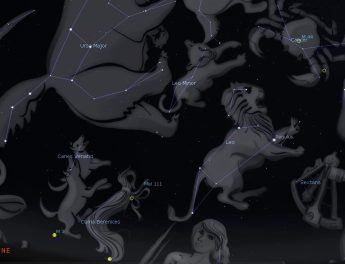This Week’s Sky at a Glance, 2025 Feb 15 – Feb 22
This Week’s Sky at a Glance, 2025 Feb 15 – Feb 22
Winter is open cluster season for stargazers. They are also called galactic clusters because they form in the spiral arms of our galaxy. In winter we are looking toward a spiral arm opposite the centre of our Milky Way galaxy. Two such clusters, the Pleaides (M45) and the Hyades, form the shoulder and face of Taurus the Bull and they are bright enough to be seen within urban areas. Other clusters are visible to the naked eye but require a clear sky with minimal light pollution.
One of these is the Beehive cluster (M44) in the constellation Cancer the Crab, which lies between Gemini and Leo. The Beehive resembles a large glowing patch of haze to the eye and its many stars fill the view in a telescope, but large clusters like this are appreciated best with binoculars. In times long past the cluster was used as a storm predictor as it would be one of the first objects to disappear when the light clouds that precede a weather system would move in.
The Coma star cluster, or Melotte 111, lies in Coma Berenices between the tail of Leo and Canes Venatici. It is a large, somewhat sparse cluster that spills beyond the view of most binoculars, and centuries ago it was regarded as the tuft of Leo’s tail. Another one, or two, is the Double Cluster between Perseus and Cassiopeia. This pair fits within the view of a low power telescope eyepiece, but binoculars give a better perspective. Following a nearby string of stars with binos will bring you to the large Stock 2 star cluster, less spectacular but delightful to observe.
This Week in the Solar System
Saturday’s sunrise in Moncton is at 7:21 and sunset will occur at 5:45, giving 10 hours, 24 minutes of daylight (7:25 and 5:52 in Saint John). Next Saturday the Sun will rise at 7:09and set at 5:55, giving 10 hours, 46 minutes of daylight (7:13 and 6:02 in Saint John).
The Moon is near Spica on Monday, at third quarter on Thursday and below Antares Friday. Venus is near its brightest in in the evening sky, setting around 9:30 this weekend. Saturn is getting difficult to see, setting less than an hour after sunset, and by next weekend Mercury will be approaching it from below. On Sunday telescope and binocular users might see Jupiter’s moon Io disappear behind the planet at 8:42 pm and Europa emerge from Jupiter’s shadow at 10:15. Mars holds its position in the middle of Gemini, making an isosceles triangle with Castor and Pollux. Rural observers can try to see the wedge of the zodiacal light toward the west about 60 to 90 minutes after sunset.
Tune in to the Sunday Night Astronomy Show at 8 pm on the YouTube channel and Facebook page of Astronomy by the Bay.

